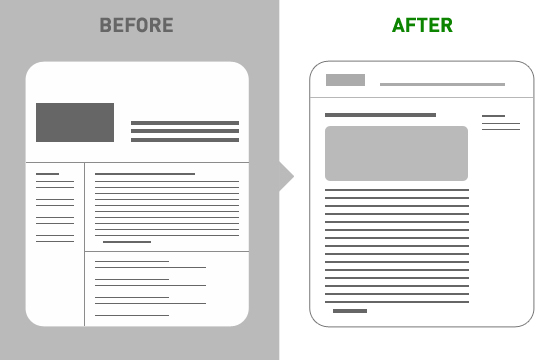What is a good click-through rate?
Many clients ask what a good click-through rate is for an email newsletter campaign. Keeping in mind that 1% is generally considered to be a respectable response rate for direct mail, I would say that you should generally shoot for somewhere between a 10-20% click-through rate for an email. The appropriate desired response to an email newsletter should be for subscribers to simply continue reading the material on your website, a much lower level of commitment than is usually implied with direct mail campaigns. That said, achieving this response isn’t the easiest thing to do. We’ve grown accustomed to being quite aggressive with email- particularly with deleting email that we find irrelevant at that moment. But over the past couple of years, I’ve noticed that certain tweaks can enable a higher and more stable click-through rate from one campaign to the next. Here are four ideas…

(1) Simplify Your Template
Overly complex email templates are the most consistent problem I see among the email newsletters I receive. The more difficulty subscribers have scanning the email and discerning its content, the more likely they are to immediately archive or delete the email. Remember, if your newsletter is not meant to be a digest of all the latest activity on your site, then it probably only has one purpose– to engage the subscriber’s interest in the latest newsletter itself enough to get them to continue reading the full article on your website. That’s it.
In the “Before” image above, you’ll see all kinds of problems. The first is that the header is far too large and emphasizes the company brand over the content of the newsletter. Branding should be subtle in this type of material, so in the “After” example, I’ve reduced its size considerably and even “lightened” it up a bit. Another problem is that the amount of extraneous information in the newsletter exceeds the actual article teaser itself, which should be the main point of the email. In my experience, this can lead to user confusion and far more clicks of other links than the primary “Read More” you are hoping they’ll click. Remove links to previous newsletters, links to sub-sections of the latest newsletter, and any other link that will distract from your main purpose. If you must have a secondary call to action, make sure that it is clearly secondary. In the “After” example above, I’ve removed all the other content and included one small call to action in the upper right of the email.
(2) Make Your Text Readable
This point is very simple: Your text is too small. Think about it- people spend a huge amount of time reading text on screens. If your text is hard to read, few will give it even a moment’s chance. Because you’re introducing more content into your subscribers’ day (yes, they’ve asked for it, but it’s easy to be overwhelmed even by the things we want) you’ve got to make it easier to read than most of what your subscribers are already facing. Otherwise, it will be easier for them to ignore your campaign. Designers, you tend to have a hard time with this; for some reason, you seem to think that small text always looks cooler. Maybe so, but get over it. When it comes to email newsletter campaigns, utility trumps fashion.
(3) Use Editorial Imagery
Designers, if I alienated you in point #2, I hope this one will win you back. Using imagery is one of the best ways to quickly attract interest in your material. Often, a picture or symbol can be a simpler and faster way to communicate a concept than the written word, so leading with an image can make it much easier for your subscribers to understand what you are offering in your article. In the “Before” example above, the logo and tagline in the header are the largest pieces of imagery in the newsletter. But in the “After” example, they’ve been reduced considerably to give priority to the editorial image at the beginning of the article teaser. Making that image linkable to the full article is a great way to encourage more subscribers to move from the email back to your site.
(4) Improve Your Writing
I saved this point for last, because it’s the hardest thing to say and the hardest thing to do. Frankly, most business writing is of very poor quality. But fortunately, most people are capable of much better writing than they actually produce. This doesn’t mean that everyone has what it takes to be a great writer, but everyone can improve. First, I’d recommend reading On Writing Well by William Zinsser. It’s a simple to read but enormously helpful book for anyone who needs to write in a professional setting, full of easy to understand principles and many sensible ways to apply them. Keep this book at your desk and make it your go-to resource for any writing you do at work.
Practically, however, one of the best ways to improve your writing is to give yourself the time you actually need to write well. It’s not like dashing off an email- it should not be taken to casually or rushed. If you need to write regularly, then you need to set aside time and make it a priority to use that time for writing. I wrote quite a bit about the discipline of writing and we have many writing-related resources on our site. Here are a few:
